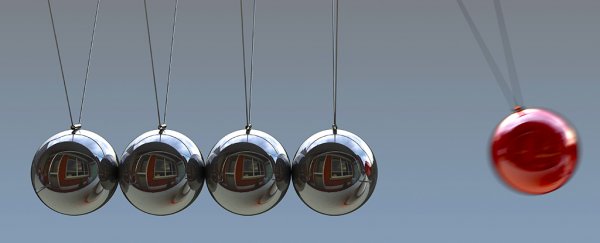A fundamental force of nature is an attraction or repulsion between objects as described through interactions between fields and particles.
Physics has identified four basic types of these interactions, which together describe every action we see in the Universe, from the decay of atomic particles to the drift of entire galaxies.
What is the strong nuclear force?
The strong nuclear force is what holds together the nuclei of atoms.
The protons and neutrons making up an atom's nucleus are themselves made up of a trio of simpler particles called quarks. A particle called a gluon acts on a property of quarks called colour, creating the force's pull.
Unlike the other three fundamental forces, the further the gluon needs to travel, the stronger the nuclear force gets. On the scale of protons and neutrons, this spring-like effect makes it incredibly hard to pull quarks apart. This helps explain why the strong force is so, well, strong.
On a scale of an atom's entire nucleus, the force also binds whole protons and neutrons to each other. Protons also push each other away thanks to the electromagnetic force, putting atomic nuclei into a delicate balance.
What is electromagnetism?
Electromagnetism is both an attractive and repulsive force between particles with a property called charge, which come in two varieties - positive and negative. Objects of like charge will have a repulsive effect on each other, while objects of unlike charges will have an attractive effect.
This is the force that's most obvious in our day-to-day lives. Thanks to the interactions of negatively-charged electrons and positively-charged protons, it allows single atoms to combine into different materials. The force is also carried through the electromagnetic field by a particle called a photon, which thanks to chemical changes in our eyes our bodies sense as light.
What is the weak nuclear force?
Of all the fundamental forces, the weak nuclear force is the trickiest to grasp. It describes how the quarks that make up nuclear particles can change from one form into another. The force is carried by particles called W and Z bosons.
The weak force acts over an incredibly short distance, equal to about 0.1 percent of the diameter of a proton. When a particle such as a neutrino comes right up close to a quark, the weak force causes the quark to change by sending out a W boson. This can turn a neutron into a proton (creating a whole new element in the process), and the neutrino into an electron.
What is gravity?
Gravity is an attractive force between masses, which according to general relativity occurs as a result of the effect of energy acting on a spacetime field. While theory suggests it could have a mediating particle - called a graviton - experiments are yet to support its existence.
While gravity might appear to be a strong force, responsible for holding entire galaxies together and squeezing the literal daylight out of stars, it's approximately 10^29 times weaker than the weak nuclear force. That means it has virtually no observable effect on the scale of tiny particles, becoming relevant only on a more cosmic level.
Are there more than four fundamental forces?
While the Standard Model of physics only describes four force carriers and their effects, there is little to prevent more forces from hypothetically existing in alternative models.
Glimpses of potentially new particles with the characteristics of an unknown force carrier have been captured in high energy experiments in recent years. The subtle effects of this force could be seen in the directions subatomic particles take as they're emitted during some kinds of decay. Their existence could even be an explanation for dark matter.
For now, any additional forces are highly speculative. Future experiments could rule them out, or - just maybe - find new physics that shows there are more than four forces in the Universe.
All Explainers are determined by fact checkers to be correct and relevant at the time of publishing. Text and images may be altered, removed, or added to as an editorial decision to keep information current.
